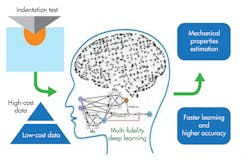Machine Learning Technique Improves Material Testing in Manufacturing
Harnessing the power of machine learning, scientists have developed a material testing technique that improves the accuracy of a previous technique used in manufacturing.
Nano-indentation is a process used for poking a sample of a material with a sharp needle-like tip to see how the material responds by deforming. The technique has had poor accuracy in obtaining certain key mechanical properties of a material, which has prevented it from being used widely in the manufacturing industry.
The new technique is a hybrid approach that combines machine learning with nano-indentation techniques. It involves using the standard nano-indentation process and feeding its experimentally measured data to a neural network machine learning system. The scientists then developed and “trained” the system to predict samples’ yield strength 20 times more accurately than existing methods.
According to the researchers—a team from Nanyang Technological University, Singapore (NTU Singapore), Massachusetts Institute of Technology (MIT) and Brown University—the new analytical technique is able to reduce the need for time-consuming and costly computer simulations in the manufacture of parts. The technique tests whether parts are safe to use in real-life conditions and can be employed in structural applications such as airplanes and automobiles, as well as those made from digital manufacturing techniques such as 3D printing.
“By incorporating the latest advances in machine learning with nano-indentation, we have shown that it is possible to improve the precision of the estimates of material properties by as much as 20 times,” reported NTU Distinguished University Professor Subra Suresh, the senior corresponding author of the paper.
In addition to improving the precision of the estimates of material properties by as much as 20 times, Suresh noted, the research also validates the system’s predictive capability and accuracy enhancement on conventionally manufactured aluminum alloys and 3D-printed titanium alloys. “This points to our method’s potential for digital manufacturing applications in Industry 4.0, especially in areas such as 3D printing,” he said.
The findings will be published in the Proceedings of the National Academy of Sciences.
A Hybrid Approach
The process starts with pressing a hard tip—typically made of a material-like diamond—into the sample material at a controlled rate with precisely calibrated force, while constantly measuring the penetration depth of the tip into the material being deformed.
To improve accuracy, the NTU, MIT and Brown team developed an advanced neural network—a computing system modelled loosely on the human brain—and “trained” it with a combination of real experimental data and computer-generated data. The researchers’ “multi-fidelity” approach incorporated real experimental data as well as physics-based and computationally simulated “synthetic” data (from both two-dimensional and three-dimensional computer simulations) with deep learning algorithms.
Previous attempts at using machine learning to analyze material properties mostly involved the use of synthetic data generated by the computer under unrealistically perfect conditions—for instance, where the shape of the indenter tip is perfectly sharp, and the motion of the indenter is perfectly smooth. The measurements predicted by machine learning were inaccurate as a result.
However, training the neural network initially with synthetic data, then incorporating a relatively small number of real experimental data points, was shown to improve the accuracy of the results.
The researchers also report that the training with synthetic data can be done ahead of time, with a small number of real experimental results to be added for calibration when it comes to evaluating the properties of actual materials.
“The use of real experimental data points helps to compensate for the ideal world that is assumed in the synthetic data,” said Suresh. “By using a good mix of data points from the idealized and real world, the end result is drastically reduced error.”
About the Author

Rehana Begg
Editor-in-Chief, Machine Design
As Machine Design’s content lead, Rehana Begg is tasked with elevating the voice of the design and multi-disciplinary engineer in the face of digital transformation and engineering innovation. Begg has more than 24 years of editorial experience and has spent the past decade in the trenches of industrial manufacturing, focusing on new technologies, manufacturing innovation and business. Her B2B career has taken her from corporate boardrooms to plant floors and underground mining stopes, covering everything from automation & IIoT, robotics, mechanical design and additive manufacturing to plant operations, maintenance, reliability and continuous improvement. Begg holds an MBA, a Master of Journalism degree, and a BA (Hons.) in Political Science. She is committed to lifelong learning and feeds her passion for innovation in publishing, transparent science and clear communication by attending relevant conferences and seminars/workshops.
Follow Rehana Begg via the following social media handles:
X: @rehanabegg
LinkedIn: @rehanabegg and @MachineDesign

